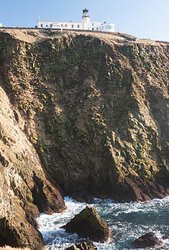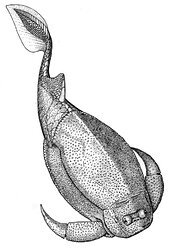Geology
 Sumburgh Head cliffs are Old Red Sandstone (image, Frank Bradford)
Sumburgh Head is formed from sediments that were laid down between 394-384 million years ago, during the Devonian Period.
Sumburgh Head cliffs are Old Red Sandstone (image, Frank Bradford)
Sumburgh Head is formed from sediments that were laid down between 394-384 million years ago, during the Devonian Period.
The Devonian Period followed the closure of the Iapetus Ocean when ‘North America’ and ‘Europe’ collided, to form a supercontinent and a huge mountain chain. Shetland was in the heart of the supercontinent, near the Equator, in the eroding foothills of the mountains. A vast desert plain extended to the south-east with open sea beyond. Fast flowing rivers washed boulders, pebbles, sand and mud down the mountains, dumping large stones at their base. Finer material was carried away by braided rivers and deposited on floodplains and in temporary lakes. The conglomerates, sandstones and mudstones that resulted are collectively known as Old Red Sandstone.
 Asterolepsis thule - image by Phillipe Janvier
A small, now inaccessible, quarry in the cliffs below Sumburgh Lighthouse exposes sediments that were laid down at the bottom of a long-vanished lake about 385 million years ago. These include a bed of impure limestone containing fossilised fish remains. Fossil beds like this are used to work out the relative ages of rocks in Britain and help us understand the geological evolution of the British Isles. Among the fossils present at Sumburgh Head are the remains of the fish Asterolepis thule, which was first discovered at this site.
Asterolepsis thule - image by Phillipe Janvier
A small, now inaccessible, quarry in the cliffs below Sumburgh Lighthouse exposes sediments that were laid down at the bottom of a long-vanished lake about 385 million years ago. These include a bed of impure limestone containing fossilised fish remains. Fossil beds like this are used to work out the relative ages of rocks in Britain and help us understand the geological evolution of the British Isles. Among the fossils present at Sumburgh Head are the remains of the fish Asterolepis thule, which was first discovered at this site.

